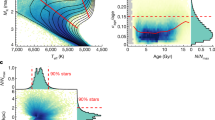Abstract
HST trigonometric distances, photometric metallicities, isochronic ages from the second revised version of the Geneva-Copenhagen survey, and uniform spectroscopic Fe and Mg abundances from our master catalog are used to construct and analyze the age-metallicity and age-relative Mg abundance relations for stars of the thin disk. The influences of selection effects are discussed in detail. It is demonstrated that the radial migration of stars does not lead to appreciable distortions in the age dependence of the metallicity. During the first several billion years of the formation of the thin disk, the interstellarmaterial in this disk was, on average, fairly rich in heavy elements (〈[Fe/H]〉 ≈ −0.2) and poorly mixed. However, the metallicity dispersion continuously decreased with age, from σ [Fe/H] ≈ 0.22 to ≈0.13. All this time, the mean relative abundance of Mg was somewhat higher than the solar value (〈[Mg/Fe]〉 ≈ 0.1). Roughly four to five billion years ago, the mean metallicity began to systematically increase, while retaining the same dispersion; the mean relative Mg abundance began to decrease immediately following this. The number of stars in this subsystem increased sharply at the same time. These properties suggest that the star-formation rate was low in the initial stage of formation of the thin disk, but abruptly increased about four to five billion years ago.
Similar content being viewed by others
References
B. A. Twarog, Astrophys. J. 242, 242 (1980).
B. Stromgren, Observatory Astrophys. Lab. Univ. Helsinky Rep. 6, 7 (1984).
V. A. Marsakov, A. A. Suchkov, and Yu. G. Shevelev, Astrophys. Space Sci. 172, 51 (1990).
B. Edvardsson, J. Andersen, B. Gustafsson, et al., Astron. Astrophys. 275, 101 (1993).
S. Feldzing, J. Holmberg, and J. R. Hurley, Astron. Astrophys. 377, 911 (2001).
B. Nordstrom, M. Mayor, J. Andersen, et al., Astron. Astrophys. 418, 989 (2004).
J. Holmberg, B. Nordstrom, and J. Andersen, Astron. Astrophys. 501, 941 (2009); arXiv:0811.3982v1 [astroph] (2008).
D. S. Sivia, Data Analysis: A Baysian Tutorial (Clarendon, Oxford, 1996).
F. Pont and L. Eyer, Mon. Not. R. Astron. Soc. 351, 487 (2004).
H. J. Rocha-Pinto, W. J. Maciel, J. Scalo, and C. Flynn, Astron. Astrophys. 358, 850 (2000).
H. J. Rocha-Pinto, C. Flynn, J. Scalo, et al., Astron. Astrophys. 423, 517 (2004).
H. J. Rocha-Pinto, R. H. O. Rangel, G. F. Porto de Mello, et al., Astron. Astrophys. 453, L.9 (2006).
M. Grenon, J. Astrophys. Astron. 8, 123 (1987).
Yu. G. Shevelev and V. A. Marsakov, Astron. Zh. 72, 321 (1995) [Sov. Astron. 35, 284 (1991)].
N. Reid, E. L. Turner, M. C. Turnbull, et al., Astrophys. J. 665, 767 (2007).
M. Haywood, Mon. Not. R. Astron. Soc. 337, 151 (2002).
P. Demarque, J.-H. Woo, Y.-C. Kim, and S. K. Yi, Astrophys. J. Suppl. Ser. 155, 667 (2004).
M. Haywood, Mon. Not. R. Astron. Soc. 371, 1760 (2006).
M. Haywood, Mon. Not. R. Astron. Soc. 388, 1175 (2008).
R. Roskar, V. P. Debattista, T. R. Quinn, et al., in The Galaxy Disk in Cosmological Context, Proceedings of the IAU Symp. No. 254, Ed. by J. Andersen, J. Bland-Hawthorn, and B. Nordstr’om(Cambridge Univ., Cambridge, 2009), p. 64.
Y. Karatas, S. Bilir, and W. J. Shuster, Mon. Not. R. Astron. Soc. 360, 1345 (2005).
W. J. Schuster, T. C. Beers, R. Michel, et al., Astron. Astrophys. 422, 527 (2004).
J. Holmberg, B. Nordstrom, and J. Andersen, Astron. Astrophys. 475, 519 (2007).
T.V. Borkova and V. A. Marsakov, Astron. Zh. 82, 453 (2005) [Astron. Rep. 48, 405 (2004)].
L. Girargi, A. Bressan, C. Chiosi, et al., Astron. Astrophys. 141, 371 (2000).
B. Salasnich, L. Girardi, A. Weiss, et al., Astron. Astrophys. 361, 1023 (2000).
V. V. Koval’, V. A. Marsakov, and T. V. Borkova, Astron. Zh. 86, 844 (2009) [Astron. Rep. 53, 785 (2008)].
C. Flynn, J. Sommer-Larsen, and P. R. Christensen, Mon. Not. R. Astron. Soc. 281, 1027 (1996).
K. Fuhrmann, in The First Stars, Proceedings of the MPA/ESO Workshop, Ed. by A. Weiss, T. G. Abel, and V. Hill (Springer, Berlin, 2000), p. 68.
V. A. Marsakov and A. A. Suchkov Astron. Zh. 54, 1232 (1977) [Sov. Astron. 8, 700 (1964)].
A. A. Suchkov, Astrophys. J. 535, L107 (2000).
M. Grenon, in Age des Etoiles, Proceedings of the IAU Colloquium No. 17, Paris, France, Ed. by G. Caurel de Strobel and A. M. Delpface (Observatoire de Paris-Meudon, 1972), p. 55.
V. A. Marsakov and T. V. Borkova, Pis’maAstron. Zh. 32, 419 (2006) [Astron. Rep. 49, 376 (2005)].
B. E. Reddy, D. L. Lambert, and C. Allende Prieto, Mon. Not. R. Astron. Soc. 367, 1329 (2006).
F. Matteucci, The Chemical Evolution of the Galaxy, Astrophys. Space Sci. Library, vol. 253 (Kluwer, Dordrecht, 2001).
T. Tsujimoto, K. Nomoto, Y. Yoshii, et al., Mon. Not. R. Astron. Soc. 277, 945 (1995).
G. Fasano, B. M. Poggianti, W. J. Couch, et al., Astrophys. J. 542, 673 (2000).
V. Desai, J. J. Dalcanton, A. Aragon-Salamanca, et al., Astrophys. J. 660, 1151 (2007).
D. J. Wilman, A. Oemler, J. S. Mulchaey, et al., Astrophys. J. 692, 298 (2009).
A. E. Dolphin, D. R. Weisz, and E.D. Skillman, in Resolved Stellar Populations, Ed. by D. Valls-Gabaud and M. Chavez (Astron. Soc Pacif., San Francisco, 2005).
E. Tolstoy, V. Hill, and M. Tosi, Ann. Rev. Astron. Astrophys. 47, 371 (2009).
A. A. Dariush, S. Raychaudhury, T. J. Ponman, et al., Mon. Not. R. Astron. Soc. 405, 1873 (2010).
Author information
Authors and Affiliations
Additional information
Original Russian Text © V.A. Marsakov, V.V. Koval’, T.V. Borkova, M.V. Shapovalov, 2011, published in Astronomicheskii Zhurnal, 2011, Vol. 88, No. 8, pp. 726–742.
Rights and permissions
About this article
Cite this article
Marsakov, V.A., Koval’, V.V., Borkova, T.V. et al. The age-metallicity relation in the thin disk of the galaxy. Astron. Rep. 55, 667–682 (2011). https://doi.org/10.1134/S1063772911080063
Received:
Accepted:
Published:
Issue Date:
DOI: https://doi.org/10.1134/S1063772911080063




